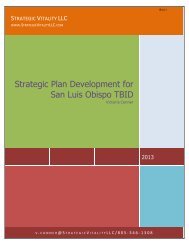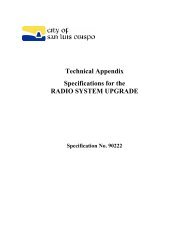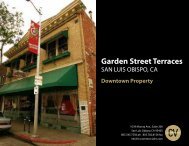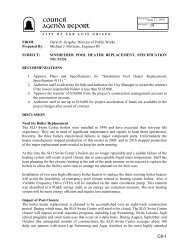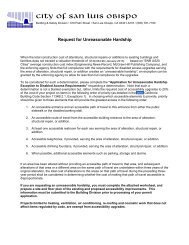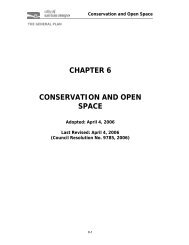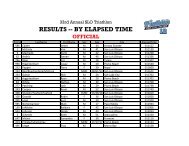Drainage Design Manual - the City of San Luis Obispo
Drainage Design Manual - the City of San Luis Obispo
Drainage Design Manual - the City of San Luis Obispo
Create successful ePaper yourself
Turn your PDF publications into a flip-book with our unique Google optimized e-Paper software.
• Exotic vegetation on <strong>the</strong> site should be removed in accordance with approvedrevegetation goals, plans and specifications.11.7 Project Planning and SchedulingTiming for a revegetation project is critical. Early planning to insure availability <strong>of</strong>plant materials for fall planting is essential. Lead-time for plants that need to becontract grown can be one to two years (contract growing is <strong>of</strong>ten necessary becausemany native plants required for revegetation are not always commercially available).On certain project sites, effective pre-planning weed control can take an entire year ormore. Fall is a much better time for planting and establishing vegetation than <strong>the</strong>summer. The best survival rates for plants planted on mid to lower creek banks areafter <strong>the</strong> chance <strong>of</strong> flooding is past. Timing <strong>of</strong> grass seeding is also critical. Properlytimed grass seeding is especially important where irrigation is not available, andwhere erosion control from grass growth is desired.11.7.1 Planting Site Preparation• Soil PreparationFor sites that have not been adversely affected by construction activities or preprojectimpacts, preparation <strong>of</strong> site soils is not generally necessary prior toplanting revegetation plants. However, <strong>the</strong> potential for a successful revegetationproject is greatly hindered on sites where soil compaction, poor drainage, loss <strong>of</strong>topsoil, and/or excessive ruderal or exotic vegetation occur. In cases wheresignificant disturbances to existing soils are unavoidable, stockpiling <strong>of</strong> topsoils is<strong>of</strong>ten a valuable practice. This is especially true on sites where subsoils areunfavorable for revegetation. Subsoils should be ripped and cross-ripped prior tospreading stockpiled topsoil.Pre-project assessments <strong>of</strong> <strong>the</strong> grass and herbaceous cover growing in areasproposed for revegetation should identify weed species and prescribe methods forcontrolling <strong>the</strong>m both before topsoils are stockpiled, and again after <strong>the</strong>y arespread. Compacted soils may be rectified by ripping, disking and/or rototilling.On steep gradients where erosion may be a problem, tillage operations should beperformed across-slope ra<strong>the</strong>r than up/down slope. Poor soil structure andpermeability can be improved by incorporating organic soil conditioners into <strong>the</strong>top six to eight inches <strong>of</strong> <strong>the</strong> soil. Suitable amendments include chopped straw(free <strong>of</strong> seeds), mushroom compost, rice hulls, sawdust, ground fir bark, and/oro<strong>the</strong>r materials. Because <strong>of</strong> <strong>the</strong> high cost <strong>of</strong> <strong>the</strong>se materials, soil conditioners arenot generally recommended for most revegetation projects. However, <strong>the</strong>ir use onseverely disturbed sites may significantly increase <strong>the</strong> initial survival percentage<strong>of</strong> revegetation plants. If revegetation goals include seeding, careful seedbedpreparation will increase germination and establishment potential.SLO Creek <strong>Drainage</strong> <strong>Design</strong> <strong>Manual</strong> 150 February 2003



